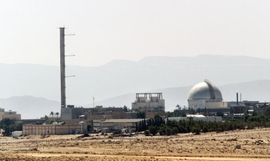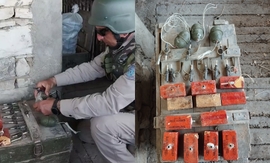Less than a day after killing five civilians with missile fire in the Barda city of Azerbaijan on Tuesday, Armenia's armed forces shelled the city again on October 28 with prohibited cluster bombs claiming the lives of dozens.
Armenian troops hit the densely populated city center to kill 21 civilians, including children, and wound 70 others, according to a statement issued by the Prosecutor General's Office of Azerbaijan. Civilian infrastructure in Barda, including a hospital and a trade center suffered serious damages.
Azerbaijan National Agency for Mine Action (ANAMA) reported that the city was shelled with Russia-made 9M525 Smerch rockets. 9M525 is a missile with cluster warhead, curb militant splinter cell type. It contains 75 pieces of 9N210 fragmentation bombs. The use of Smerch missiles is prohibited.
"Armenian armed forces, grossly violating the humanitarian ceasefire regime, have fired at the Barda city from the "Smerch" multiple launch rocket system," Azerbaijan's Defense Ministry announced in a statement.
Hikmat Hajiyev, senior aide to the president of Azerbaijan, has confirmed the use of prohibited cluster bombs in the attacks on Barda.
"Armenia used cluster munitions to inflict excessive casualties among civilians. It is policy of state terror by Armenia," he said, adding Armenian army's shelling the city center of Barda, which is located about 50 kilometers from the battlefield in Azerbaijan's Karabakh region, is a war crime.
A cluster munition, or cluster bomb, is a weapon that contains multiple explosive submunitions. Cluster munitions are dropped from aircraft or fired from the ground or sea, opening up in mid-air to release tens or hundreds of submunitions, which can shell an area up to the size of several football fields. The international Convention on Cluster Munitions (CCM) treaty addresses the prohibition of the use, transfer, and stockpiling of cluster bombs. As of September 2020, 123 states have committed to the goals of the Convention, of which 110 have become States Parties and 13 are Signatories.
Wednesday's attack on Barda followed the missile fire by the Armenian troops on the city a day before on October 27, when at least 5 civilians were killed and 13 were injured. On October 26, a humanitarian ceasefire brokered by the United States came into force between Armenia and Azerbaijan. Similar to two previous Russia-mediated truces on October 10 and 17, Armenia has blatantly violated the last armistice, as well, to hit civilians.
The fighting between Armenia and Azerbaijan sparked on September 27 after heavy shelling of Azerbaijani military and civilian positions by Armenia's armed forces deployed in the occupied Azerbaijani lands. The uninterrupted bombardment triggered immediate counter-attack measures from the Azerbaijani military to push the Armenian offensive back. Intensive deployment of military materiel and personnel to the frontline by both sides transitioned the fighting into the largest-scale clashes between the sides since a ceasefire reached in 1994.
Armenia has regularly targeted civilian settlements, including hospitals, schools, residential buildings, a police station, a cotton plant, a hydropower station, and energy pipelines in multiple cities of Azerbaijan since the start of hostilities. Armenia's forces killed 90 civilians and wounded around 400, while destroyed and damaged over 2,300 houses, 92 multi-apartment residential buildings, and 415 civil facilities as of October 29.
Armenia and Azerbaijan have been locked in a decades-old conflict over the Nagorno-Karabakh region, which is the internationally recognized territory of Azerbaijan but occupied by Armenia. Following the Soviet Union’s dissolution in 1991, Armenia launched a military campaign against Azerbaijan that lasted until a ceasefire deal was reached in 1994. Armenia occupied 20 percent of Azerbaijan’s internationally recognized territories including the Nagorno-Karabakh region and seven surrounding districts. Over 30,000 ethnic Azerbaijanis were killed and one million were expelled from those lands in a brutal ethnic cleansing policy conducted by Armenia.
Despite four UN resolutions demanding the immediate withdrawal of Armenian forces from occupied lands and the return of internally-displaced Azerbaijanis to their native lands, Armenia has repeatedly refused to pull its forces out of the occupied territories.







 Russian peacekeeping forces, deployed in the Karabakh (Garabagh) region of Azerbaijan since 2020, have commenced their withdrawal from the area.
Russian peacekeeping forces, deployed in the Karabakh (Garabagh) region of Azerbaijan since 2020, have commenced their withdrawal from the area.
 Azerbaijan officially unveiled the logo for the upcoming 29th session of the Conference of the Parties to the United Nations Framework Convention o...
Azerbaijan officially unveiled the logo for the upcoming 29th session of the Conference of the Parties to the United Nations Framework Convention o...
 The Kazakh authorities have increased their arbitration claims against international oil companies involved in the development of the Kashagan oil ...
The Kazakh authorities have increased their arbitration claims against international oil companies involved in the development of the Kashagan oil ...



